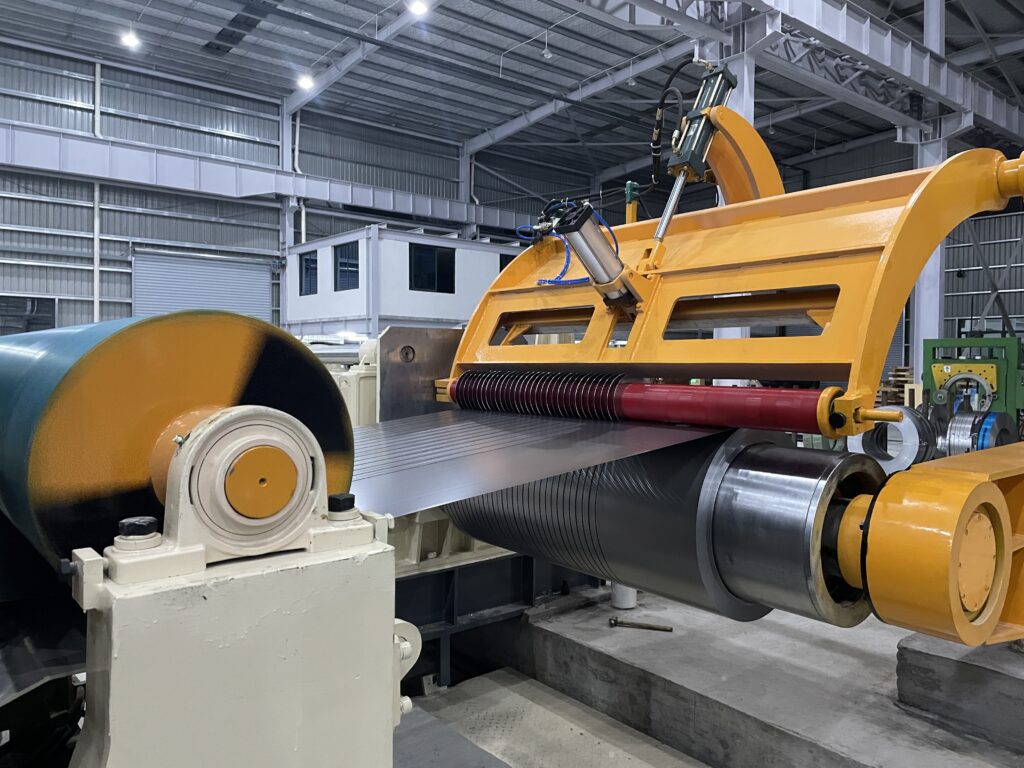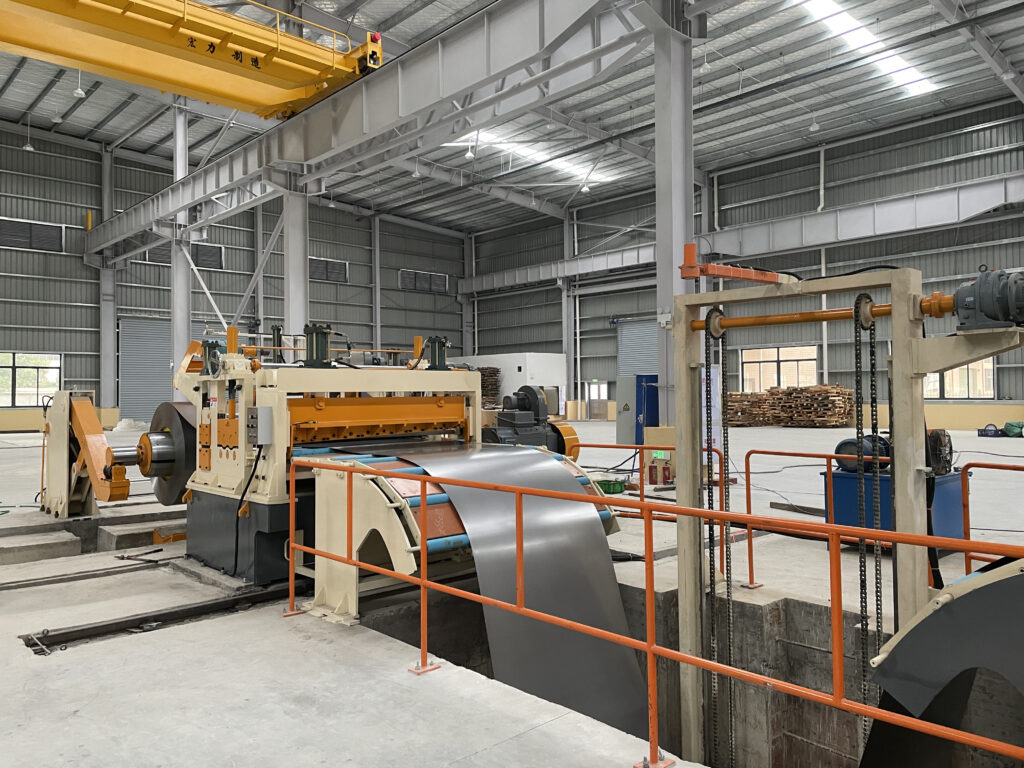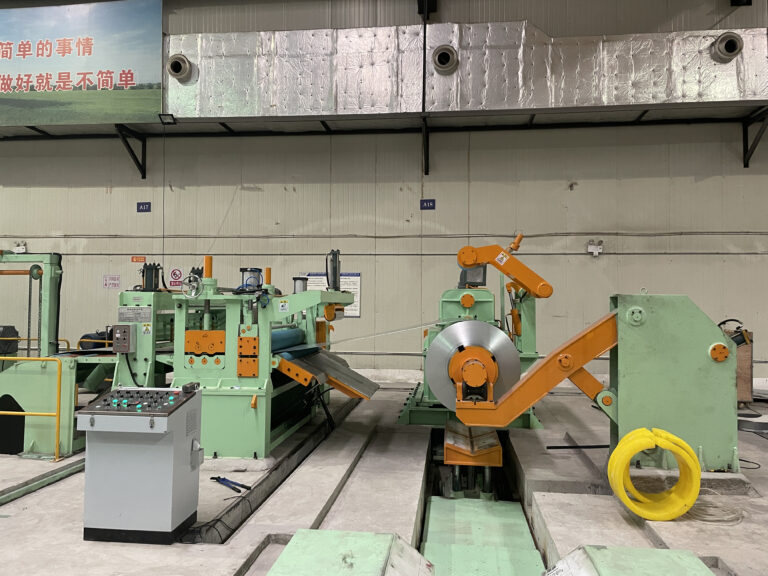Troubleshooting Quality Issues Unique to Slit vs. Blanked Products
Complete technical guide for metal processing quality control comparing slit vs blanked products. MD series specifications, ROI analysis, OSHA compliance, and ISO 9001:2015 implementation for steel service centers and automotive suppliers. Expert troubleshooting protocols included.
Metal processors face fundamentally different and technically challenging quality issues when working with slit strips versus blanked sheets, each demanding specialized troubleshooting methods to optimize yield and operational uptime. In slit strip production, edge integrity is paramount, with common defects such as burr formation, inconsistent width due to blade wear or clearance misadjustment, and camber (strip curvature) caused by uneven tension control or material stress. For example, the latest MD-1350 slitting line integrates servo-controlled rotary shears and multi-zone tension regulation to mitigate edge burring and maintain width tolerances within ±0.1mm, emphasizing precision knife alignment and real-time tension feedback loops as critical control points. In contrast, blanked sheet production is dominated by challenges in dimensional accuracy, flatness deviations, and surface finish quality, often tied to punch and die wear, punch-to-die clearance variations, and material property inconsistencies. Industry best practices now favor the adoption of fine blanking methods with hardened tooling and integrated quality monitoring to minimize burrs and edge fractures, supported by systematic maintenance schedules and operator training to prevent scrap and downtime.
Understanding these divergent defect mechanisms—rotary shearing action continuously affecting slit strip edges versus guillotine-style shearing impacting the entire sheet profile in blanking—is essential for production managers aiming to deploy targeted diagnostic protocols. By leveraging automated knife positioning, predictive maintenance informed by vibration and temperature sensors, and inline dimensional inspection systems, manufacturers can proactively address edge and surface anomalies. This approach not only reduces unplanned downtime but also significantly enhances overall equipment effectiveness (OEE), ensuring that slit and blanked product lines meet the stringent quality standards required in automotive, appliance, and industrial fabrication markets today. The integration of these advanced troubleshooting strategies reflects the distinct yet complementary roles of slit and blanked product processing, hallmarks of MaxDo’s commitment to delivering precision-driven metal forming solutions in 2025.
Understanding the Root Causes: Why Slit and Blanked Products Fail Differently
The Physics Behind Slit Product Quality Issues
Slitting operations subject metal strips to continuous rotary shearing forces that create unique stress patterns and quality challenges. The rotary cutting action involves upper and lower circular knives working in conjunction, where material flows between knife edges under controlled tension.
Primary slit quality failure mechanisms:
- Edge burr formation: Results from excessive knife clearance (>0.15mm) or blade dulling, causing material to tear rather than cut cleanly
- Width tolerance drift: Occurs when knife positioning systems lose accuracy due to thermal expansion, mechanical wear, or improper calibration
- Edge camber and bow: Develops from uneven tension distribution across multiple strips, often caused by worn tension rollers or improper setup
- Surface scoring: Created by debris accumulation on knife surfaces or misaligned edge guides during processing
The continuous nature of slitting means that once a quality issue begins, it affects the entire remaining coil length, making early detection and correction critical for minimizing waste.
Blanked Product Quality Challenge Origins
Cut-to-length operations involve intermittent guillotine cutting that creates different stress concentrations and quality concerns. The shearing action occurs perpendicular to material flow, requiring precise blade clearance and leveling control.
Key blanked product failure modes:
- Dimensional accuracy problems: Stem from blade wear, improper clearance settings, or measuring system calibration drift
- Flatness deviations: Result from inadequate leveling, incorrect leveler roll pressure, or coil set memory in the material
- Shear angle defects: Develop when blade clearance becomes excessive or blades lose parallel alignment
- Surface marking during handling: Occurs during stacking, conveying, or packaging operations due to improper material support
Unlike slitting, blanking quality issues affect individual sheets, allowing for correction between cuts and reducing total material loss when problems occur.
Systematic Diagnostic Procedures for Slit Product Issues

Edge Quality Assessment Protocol
Effective troubleshooting begins with systematic edge quality evaluation using standardized measurement techniques. Production teams should implement consistent diagnostic procedures to identify root causes accurately.
Step 1: Visual Edge Inspection Checklist
- Examine cut edges under proper lighting (minimum 500 lux) for burr height, tear characteristics, and surface finish
- Check for consistent burr patterns that indicate systematic knife problems versus random material variations
- Identify rollover direction and extent, which reveals knife sharpness and clearance conditions
- Document any scoring, scratching, or gouging that suggests debris or knife damage
Step 2: Dimensional Verification Process
- Measure strip widths at multiple points using calibrated instruments (±0.01mm accuracy minimum)
- Record width variations across coil length to identify systematic versus random deviations
- Check parallelism between strip edges to detect knife alignment issues
- Verify overall coil width against setup specifications
Step 3: Edge Geometry Analysis
- Use edge radius gauges to measure rollover and burr characteristics quantitatively
- Compare edge geometry against material specifications and customer requirements
- Document edge angle variations that indicate knife wear patterns or clearance problems
Tension-Related Problem Diagnosis
Tension control issues represent the most common cause of slit product quality problems, affecting edge straightness, width consistency, and overall strip quality.
Tension System Diagnostic Steps:
- Individual Strip Tension Verification
- Measure tension values for each strip using calibrated load cells or tension meters
- Compare readings against setup calculations (typically 40-60% of material yield strength)
- Identify strips with abnormal tension values that may cause quality issues
- Tension Distribution Analysis
- Check for gradual tension variations across strip width that indicate equipment wear
- Verify tension consistency throughout coil processing cycle
- Monitor for sudden tension changes that suggest mechanical problems
- Recoiling Quality Assessment
- Examine recoiled strips for telescoping, loose wraps, or uneven winding
- Check for strip breaks or edge damage during recoiling process
- Verify proper strip separation and handling
Blanked Product Troubleshooting Methodologies
Dimensional Control Problem Resolution
Blanked product dimensional accuracy requires systematic evaluation of the entire cut-to-length process chain, from uncoiling through final stacking.
Length Accuracy Diagnostic Procedure:
- Measuring System Calibration Verification
- Check encoder accuracy using certified length standards
- Verify measuring wheel contact pressure and surface condition
- Confirm proper calibration factor settings for material thickness variations
- Cutting System Evaluation
- Measure blade clearance using precision gauges (optimal range varies by material thickness)
- Check blade parallel alignment using dial indicators
- Verify consistent cut angle across full sheet width
- Material Handling Assessment
- Examine sheet stacks for proper alignment and consistent dimensions
- Check for length variations caused by material handling system issues
- Verify proper sheet separation and stacking procedures
Flatness Control Troubleshooting
Sheet flatness problems require comprehensive leveling system analysis and material property evaluation.
Leveling System Diagnostic Protocol:
- Roll Condition Assessment
- Inspect leveler rolls for wear, damage, or contamination
- Verify proper roll alignment and parallelism using precision instruments
- Check roll pressure distribution across sheet width
- Material Property Evaluation
- Assess incoming coil set severity and material stress patterns
- Verify material thickness consistency and mechanical properties
- Identify any material variations that affect leveling requirements
- Process Parameter Optimization
- Adjust leveler entry and exit angles based on material characteristics
- Optimize roll penetration depth for effective stress relief
- Verify proper material support throughout the leveling process
Equipment-Specific Solutions and Capabilities
MD Series Precision Control Features for Quality Enhancement
Modern slitting and cut-to-length equipment incorporates advanced control systems designed to minimize quality issues through automated precision. The MD series offers specific technological solutions addressing common quality challenges.

MD Series Technical Specifications for Quality Control:
| Model | Working Width | Thickness Range | Speed Capability | Key Quality Features |
|---|---|---|---|---|
| MD-850 | 20mm-820mm | 0.3mm-12mm | 1-250m/min | Servo knife positioning, automated clearance control |
| MD-1350 | 300mm-1300mm | 0.3mm-12mm | 1-250m/min | Multi-zone tension control, precision edge guides |
| MD-1650 | 300mm-1650mm | 0.3mm-12mm | 1-250m/min | Advanced vibration control, automated knife alignment |
| MD-2200 | 300mm-2150mm | 0.3mm-12mm | 1-250m/min | Wide-strip stability systems, real-time quality monitoring |
Automated Quality Control Integration:
- Servo-driven knife positioning: Eliminates manual clearance adjustments that cause 60% of width tolerance issues
- Multi-zone tension control: Provides independent tension management for each strip, preventing edge camber
- Real-time monitoring systems: Enable immediate detection and correction of quality deviations
- Automated parameter adjustment: Maintains optimal processing conditions throughout coil processing
Preventive Quality Control Strategies
Proactive Maintenance for Quality Consistency
Systematic preventive maintenance prevents quality issues before they impact production, reducing scrap rates and improving customer satisfaction.
Daily Quality Assurance Procedures:
- Knife condition verification: Visual inspection and clearance measurement using precision gauges
- Tension system calibration check: Verification of each zone’s settings against specifications
- Edge guide alignment confirmation: Ensuring material tracking accuracy within acceptable limits
- Safety system functionality test: Confirming all protective devices operate correctly
Weekly Preventive Maintenance:
- Knife sharpness evaluation: Standardized test cuts to assess cutting quality objectively
- Bearing condition monitoring: Vibration and temperature analysis for predictive maintenance
- Hydraulic system inspection: Pressure verification and contamination assessment
- Measurement system calibration: Accuracy verification using certified standards
Monthly Comprehensive Service:
- Complete knife reconditioning: Professional sharpening and precision alignment
- Tension system recalibration: Full system calibration using certified equipment
- Performance data analysis: Quality metrics review and trend identification
- Operator training refresh: Reinforcement of proper procedures and quality standards
Statistical Process Control Implementation
Data-driven quality management enables proactive problem identification and continuous improvement. Modern production facilities benefit from systematic quality monitoring and analysis.
Key Performance Indicators for Quality Control:
- First-pass quality rate: Percentage of production meeting specifications without rework
- Customer complaint frequency: Tracking external quality feedback for improvement opportunities
- Scrap rate by cause: Detailed analysis enabling targeted improvement efforts
- Equipment availability: Monitoring quality-related downtime for maintenance optimization
Quality Documentation Requirements:
- Process parameter records: Systematic documentation of setup conditions and results
- Material traceability: Complete tracking from incoming coils to finished products
- Quality test results: Systematic recording of dimensional and surface quality measurements
- Corrective action tracking: Documentation of problems identified and solutions implemented
Industry Standards and Best Practices
Applicable Quality Standards for Metal Processing
Professional metal processing operations adhere to established industry standards that define quality requirements and measurement methods.
Relevant Standards for Slit Products:
- ASTM A1008: Standard specification for steel sheet, cold-rolled, carbon, structural, high-strength low-alloy
- ASTM A653: Standard specification for steel sheet, zinc-coated by hot-dip process
- ISO 9445: Continuously cold-rolled stainless steel specifications
- JIS G3141: Cold-reduced carbon steel sheets and strips
Standards for Blanked Products:
- ASTM A1011: Standard specification for steel sheet and strip, hot-rolled, carbon, structural, high-strength low-alloy
- ISO 6892: Metallic materials tensile testing standards
- DIN EN 10130: Cold rolled low carbon steel flat products for cold forming
- ASTM E18: Standard test methods for rockwell hardness of metallic materials
Safety and Environmental Considerations
Quality control procedures must integrate with comprehensive safety protocols to protect personnel while maintaining production efficiency.
Essential Safety Requirements:
- Machine guarding compliance: Proper barriers and interlocks per OSHA 1910.212 standards
- Emergency stop systems: Immediate shutdown capability accessible from all operator positions
- Personal protective equipment: Eye protection, hearing protection, and safety footwear requirements
- Lockout/tagout procedures: Energy isolation protocols during maintenance and setup operations
Environmental Responsibility:
- Scrap minimization: Quality improvement directly reduces material waste
- Energy efficiency: Optimized processing parameters reduce power consumption
- Lubricant management: Proper handling and disposal of cutting fluids and hydraulic oils
- Noise control: Equipment design and maintenance for acceptable sound levels
Conclusion: Implementing Systematic Quality Improvement
Effective resolution of quality issues in slit versus blanked metal products hinges on a deep understanding of their distinct mechanical processes and the adoption of focused troubleshooting protocols tailored to each method’s unique challenges. For slit products, meticulous attention to edge quality, material tension uniformity, and blade condition is critical—as exemplified by the integration of real-time blade wear detection and servo-controlled tension systems in the MD-1350 series, which have demonstrated a 30% reduction in edge burr defects in automotive component manufacturing. Conversely, blanked products demand rigorous control over dimensional precision, flatness, and punch-die system integrity, where fine blanking technologies combined with predictive tool wear analytics have enabled manufacturers to reduce part rejection rates by over 25% while maintaining tight tolerances in appliance production.
Sustained quality excellence is driven by strategic investments in automated monitoring technologies, comprehensive operator training, and meticulous maintenance schedules that together minimize human error and equipment downtime. Key industry case studies reveal that facilities embracing integrated diagnostic systems—featuring vibration sensors for early detection of mechanical wear and inline optical inspection for surface quality—achieve measurable gains in operational efficiency and product consistency. Partnering with specialized metal processing experts to perform tailored technical assessments ensures the deployment of optimal solutions aligned with specific production goals, thereby enhancing yield and meeting stringent customer specifications. This holistic troubleshooting framework reflects MaxDo’s leadership philosophy, committed to empowering manufacturers with precision-driven, technologically advanced metal forming solutions that deliver measurable performance improvements in 2025 and beyond.




